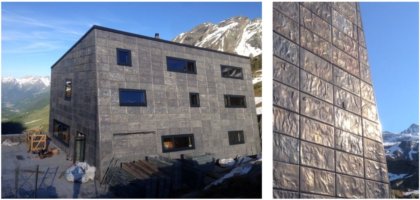POHLTEC METALFOAM GmbH

|
In August 2016 I decided to leave science and academia, got an interesting offer from pohltec metalfoam GmbH and went to Cologne to start my new adventure.
The pohltec metalfoam GmbH is the only manufacturer of single material aluminium sandwiches worldwide, i.e. foam core and cover layers are metallic, joined together
without adhesives. AFS are not only known for its particularly fascinating pored structure, but rather for its high stability, its minimum weight, what makes
it interesting for bear loading and functional applications in architecture, automotive and various very specific industries.
For further details see:
POHLTEC METALFOAM
Inspired by nature
AFS (Aluminium Foam Sandwich) is a laminar sheet-like material consisting of a foam aluminium core covered by an aluminium layer on either side. The cover layers are metallic, of the same material and are fused with the core without the need of adhesives. The special feature of AFS is that it is the only single-material aluminium sandwich system worldwide and offers completely new possibilities for applications and processing. Both, shaped and complex formed elements can be produced. For the production of complex formed sand-wich elements, first the three-layer original material is formed and then the inner core layer is foamed.
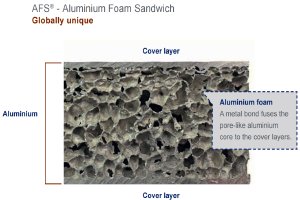
|

|
Aluminium foam sandwich AFS sheets can be cut by laser cutting <15 mm (upper left image) and by water jet cutting <25 mm (lower left image). Mechanical cutting, like milling, is possible like standard Aluminium.
Methods for welding of AFS aluminium foam sandwich sheets are TIG / MIG / laser welding. The general guidelines for welding of aluminium materials must be observed. Only the cover layers are welded while the core remains untouched and serves as a kind of welding fixture. Due to this, deformation of the components is considerably reduced. The connection core / cover layers remains completely intact. As an example for a welded aluminium foam sandwich construction, see the T-weldjoint and the more complex V-cutted, bended angle (right). Here, extruded profiles or sheets can be directly welded to the cover layer of the sandwich element. As additional welding material, AlMg4.5Mn was used.
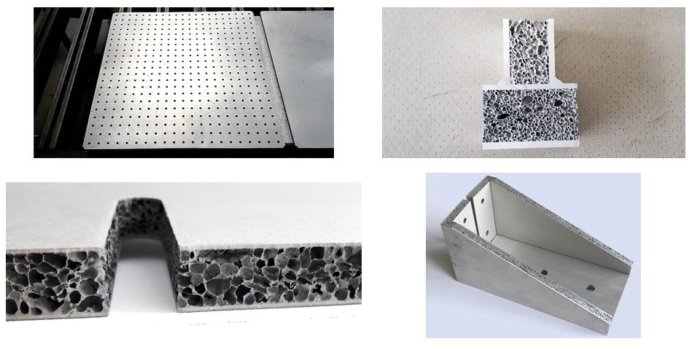
|
New approaches in sense of connection techniques are also made in cooperation with several experts in this field (EJOT, Stanley, KVT), leading to smart and impressive solutions, see the lower image. This development culminates in an Transatlantic Cluster for Lightweigt: TraClight. Since January 2017 TraCLight supports the international expansion and networking of German and North American companies and research centers. The goal is to bring together technical know-how for the development of truly unique and innovative lightweighting products through collaborative R&D projects between Germany and North America. And pohltec metalfoam is a key part of it.
For further details see: TRACLIGHT
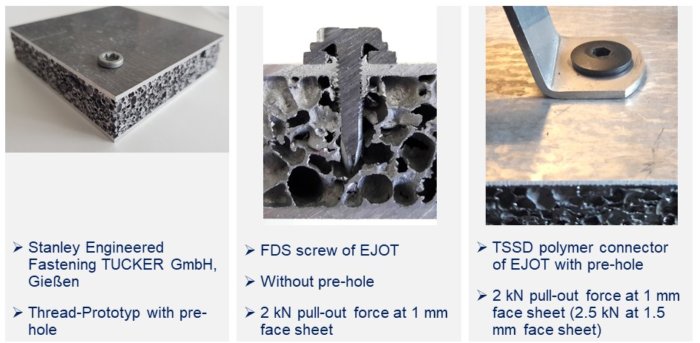
|
Aluminium foam sandwich AFS sheets can also be processed like normal aluminium sheets before foaming; the main difference is the three-layer construction consisting of aluminium cover layer / unfoamed aluminium core / aluminium cover layer. This basic sheet can be formed before foaming, is foamed in a forming tool and pressed to its final dimension while still warm in the forming tool. Since AFS can be easily formed while still warm, it is also possible to manufacture complex forged elements without damaging the core or the core/cover layer connection.
Edge areas are a problem with sandwich materials since the edges are visible and at the same time, the intrusion of liquid and dirt must be avoided. Furthermore, the edge areas are often subject to mechanical stresses. Both are main requirements for e.g. automotive industry. Apart from conventional edge sealing methods like sealing with glue and sealing compounds, adhesive tapes etc, AFS provides the alternative of sealing the edge by milling off a cover layer and the core and subsequently flattening down the remaining cover layer. AFS is the only sandwich material which can be grouted at the edges without damaging the structure.
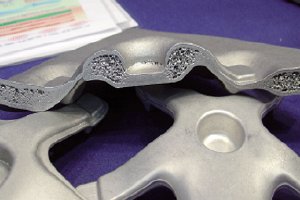
|
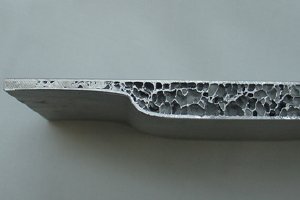
|
The development in flatten the surrounding and in novel connection techniques together with unique mechanical and functional advantages of AFS opens the door to the hot application of battery cases of electric vehicles. The designed concept battery compartment together with Handtmann GmbH & Co. KG consists of an underfloor (final layer to the street) and a floor panel (border to the passenger cabin, not shown here). Both are made of AFS and bonded to extruded aluminium alloy profiles by punch rivets and automotive adhesive, see lower image. Partial densification of some AFS areas, see upper image, was carried out to seal the elements and to connect them to the substructure by using standard connection techniques (riveting, glueing, etc.). However, the largest part of the AFS was not densified. This procedure led to an increased stiffness and impact protection, while mass was reduced. Thus, the mass specific properties were improved.

|
The architectural development of AFS-panels, the so called metalfoam design tiles (MDT), shows a crater-like, very decorative face. The most attractive surface refinements are certainly Corten steel, bronze or copper, as they support the crater-like surface visually. But basically any RAL or DB powder lacquer is possible of course. The metal tiles up to 15 mm thick are visually very appealing and do not convey the slightest hint of their true core – lightness.The metalfoam design tiles are made by hand and each one is therefore unique. The tiles are similar in their structure but never identical.


